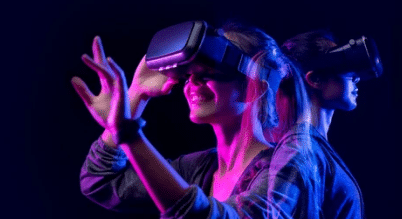Virtual Reality

Virtual reality (VR) refers to a computer-generated simulation of a three-dimensional environment that can be interacted with in a seemingly real or physical way using specialized hardware, such as a VR headset, controllers, and sensors.
In VR, users are immersed in a completely artificial environment that can be designed to simulate a real-world scenario, or create a completely fictional one. VR technology can be used for a wide range of applications, from entertainment and gaming to education, healthcare, and training.
Some potential applications of VR include:
Gaming and entertainment: VR allows for a more immersive gaming experience, enabling players to feel like they are actually in the game environment.
Education: VR can be used to create interactive and immersive learning experiences that enable students to explore and interact with historical, scientific, or cultural events.
Healthcare: VR can be used to simulate medical procedures and training, allowing medical professionals to practice and develop their skills in a safe and controlled environment.
Architecture and design: VR can be used to create 3D models of buildings and structures, allowing architects and designers to explore and modify their designs in real-time.
Travel and tourism: VR can be used to create virtual tours of popular destinations, providing travelers with a preview of their destination and enabling them to explore different areas before they arrive.
Overall, VR has the potential to revolutionize many industries by providing a more immersive, engaging, and interactive experience for users. As the technology continues to evolve and become more accessible, it is likely that we will see even more innovative applications in the future.

Virtual reality (VR) technology has several potential use cases in the medical sector, including:
- Medical training and education: VR can be used to simulate medical procedures, enabling medical professionals to practice and develop their skills in a safe and controlled environment. It can also be used to create interactive and immersive learning experiences for medical students.
- Pain management: VR can be used to distract patients from painful procedures, such as chemotherapy, by immersing them in a virtual environment that provides a sense of relaxation and reduces anxiety.
- Rehabilitation: VR can be used to aid in the rehabilitation of patients recovering from injuries or surgeries, by providing interactive and engaging exercises that promote movement and motor skills.
- Exposure therapy: VR can be used to simulate scenarios that trigger anxiety or phobias in patients, allowing them to confront and overcome their fears in a safe and controlled environment.
- Surgical planning: VR can be used to create 3D models of a patient’s anatomy, enabling surgeons to visualize and plan complex surgical procedures before they are performed.
- Telemedicine: VR can be used to provide remote consultations and medical care, enabling doctors to diagnose and treat patients who are unable to visit a physical clinic.
Overall, VR has the potential to transform the medical sector by providing innovative solutions for training, education, therapy, and treatment. As the technology continues to advance and become more widely available, it is likely that we will see even more innovative applications in the future.
Virtual reality (VR) technology has several use cases in the gaming industry, including:
- Immersive gameplay: VR can provide a more immersive and realistic gaming experience, allowing players to feel like they are actually in the game world. This can enhance the overall gameplay experience and make it more engaging and enjoyable for players.
- New game genres: VR can enable the creation of new game genres that are not possible with traditional gaming platforms, such as fully immersive adventure or exploration games.
- Multiplayer gaming: VR can enable players to interact with each other in a virtual space, making multiplayer gaming more social and immersive.
- Virtual arcades and theme parks: VR can be used to create virtual arcades or theme parks that enable players to experience a variety of games and attractions in a single location.
- Training and simulation: VR can be used to train and simulate real-life scenarios for game developers and designers, enabling them to test and refine their games in a safe and controlled environment.
Overall, VR has the potential to revolutionize the gaming industry by providing a more immersive, engaging, and interactive gaming experience. As the technology continues to advance and become more widely available, it is likely that we will see even more innovative applications in the future.




Facebook VR glass is cool. Could you please write more about that technology?